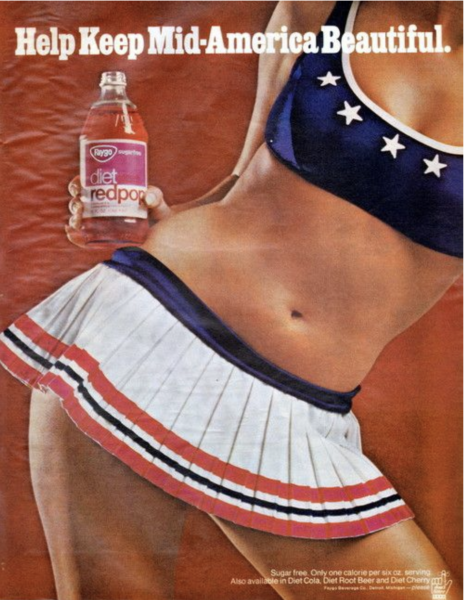The male gaze is a term used in film theory used to describe how women in movies are often portrayed as passive, sexualized objects to satisfy the desires of heterosexual men. Whether it’s films or advertisements, the male gaze is a prominent concept in today’s media. It’s visible through the way women are perceived in these various types of media. Most often, when this gaze is present, there are shots that focus on a woman’s body to highlight and sexualize it. By capturing women in this manner, it purposefully forces the audience in the perspective of a heterosexual man and what are believed to be his sexual desires, where women have no agency over themselves. As our world becomes more diverse and equality aware, why are we still being subjected to false depictions of women in so many parts of the media? It’s important for us to understand what the male gaze is, and how it can affect both men and women when forced to witness it on a regular basis.
The term ‘male gaze’ was first coined in 1972, in the docuseries Ways of Seeing. It was a series created by art critic John Berger, where he focused on Western European art, and analyzed the ways that women’s bodies were viewed and depicted. Throughout this series, Berger argued that women have been represented as passive objects specifically for men’s desires all throughout cultural and artistic history. The concept of the male gaze was furthered and popularized later in 1975 in the essay “Visual Pleasure and Narrative Cinema,” written by the feminist film theorist Laura Mulvey. In her piece, Mulvey approached the issue with psychoanalysis, and argued that mainstream movies were concentrated on satisfying male scopophilia, or the sexual pleasure of looking. She discussed that while pleasing male scopophilia, they were sexualizing and objectifying women through this heterosexual male lens.
Ever since then, her work has impacted the way film theorists analyze and create cinematic work, and has urged filmmakers to aim for more positive portrayals of women in cinema, and less depiction of the male gaze.
Even after the increased awareness of the concept after Mulvey’s essay, it has still been prominent in the media throughout the years, especially in film. As films reach wide audiences which include women within them, they’re forced to watch other women be captured as objects for male desires. There are many instances of the male gaze in popular films, however there are also examples of where directors try to minimize or get rid of it. An example of this is ‘Harley Quinn: Birds of Prey,’ directed by Cathy Yan. In an interview with the New York Times about the male gaze, Yan said, “There are choices which felt very deliberate; we were making sure we were protecting our female actors, even in a scene that was about humiliation.” She explained that she wanted to keep the camera on where the story was taking place, which was the actors’ faces, not their bodies. Yan’s aim was to always be conscious of the scene and what it was about, and transferring that to the viewer “by not offering anything remotely vulnerable or titillating.” Overall, Yan’s work was acknowledged by many, especially her goal of minimizing the male gaze in the movie. It has become one of the most popular examples of film that intentionally and consciously drove to depict the female characters as humans, and not as sexual objects.
This gaze isn’t only present in film, but also in advertisements. A clear example of this is in the following one.

This was an advertisement made in 1970 by the company Faygo, which is a soft drink company. We can see that this poster is fully focused on the body of the woman, excluding her face, and only including her torso and some of her legs. We aren’t able to see her face, however we can see that she’s wearing a very short skirt and top. The main aspect of the ad is intended to be the company’s drink, however it blends in with the red background, and it seems to purposefully bring full attention to the body of the woman. The presence of the male view is visible, as we’re obliged to only look at her chest and hips, and not even her face or the product in the ad.
Looking at this example, we can see that the male gaze can be manifested in various types of media outside of film, where women are sexualized and where the audience is unwillingly put in the position of a man. Nonetheless, in today’s world, directors are finally beginning to put conscious efforts into portraying women as what they are: humans.
With the understanding that this concept can be seen throughout the media, it’s also important to understand how it affects the audience, especially the young females that often witness this. One impact is the way women perceive themselves. When consuming media with many objectified and sexualized women, it can affect the self-esteem and perception of oneself. It’s possible for women to begin to see themselves as objects that should conform to heterosexual men’s standards, and strive to achieve those standards everyday. In romantic relationships, women might attempt to objectify themselves and act as submissive objects for their partner. Another impact on women could be focused on physical appearance. When the male gaze is present in media, the women that are being portrayed through this gaze often have an “ideal” body type: large chest, slim waist, and just generally skinny. Seeing these types of bodies can convince other young women to aim for these unrealistic and harmful ideals. While doing so, they might specifically try to please the men in their lives, because of other women being perceived in that way.
The impact, however, might not only affect women. Men and boys that often see women in the media through the male gaze might be encouraged to do so themselves in real life. This can generate the idea that all women should be passive objects to be controlled by heterosexual men. The gaze could also contribute to a man’s interpretation of masculinity, by making them believe that to be a “true” man they need to perceive and treat women as unassertive. These ideas can extend out from their mind into the world, and lead to more of a power imbalance between men and women.
The male gaze is a significant concept that is visible in the media, however is sometimes hard to notice. It’s important to understand how the male gaze is manifested in the world around us, and how it can negatively affect both women and men. Even though filmmakers and producers have been trying to take a more neutral and positive approach without the male gaze, it is still present in our world today, and it still generates misogynistic ideals of women throughout the world. Understanding and noticing the male gaze in our everyday lives can have a significant impact on how we perceive the world and how we make sense of the real diversity of women’s personalities and behavior.






